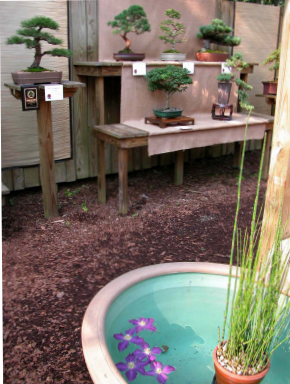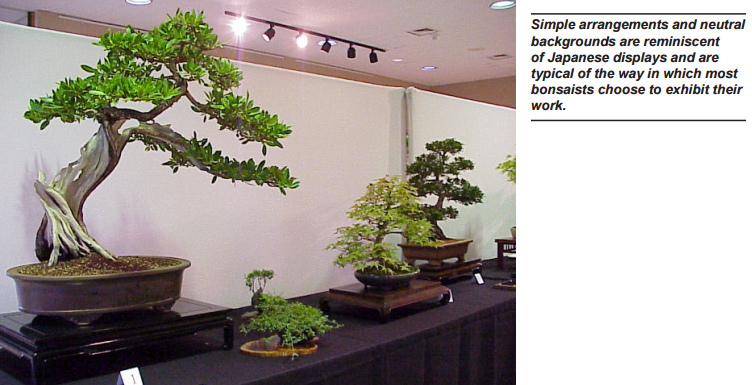How To Prepare A Bonsai For Exhibition
One of the best parts about becoming involved in bonsai is having the opportunity to show our trees to others. Indeed, growing bonsai might not be nearly as fulfilling if we did not have the opportunity to see how others react and respond to our creations.
Exhibiting a tree in a club or federation show is a perfect opportunity to do that. Not only do such shows allow us to see how others react to our horticultural creations, but they also give us the opportunity to observe what our fellow artists are up to and, by comparison, gauge our progress in the art.
Almost all club sponsored shows or exhibitions involve some type of judging or prize award system. Although the argument can be made that each bonsai is an individual artistic creation and therefore cannot fairly be judge against other works of art… the practice of judging bonsai at shows persists.
In a large sense this is a good thing, because it encourages excellence in the art. No matter whether you are a rank beginner or an accomplished expert, your bonsai deserve to be seen by others. Indeed, to create and grow bonsai and not take them to shows is a little like becoming a gourmet cook and never having anybody over for dinner.
The argument often made is that “My bonsai are not good enough for a show.” It is a hollow argument and indicates a bonsaist with little self confidence. Judging and prize awards at bonsai shows are almost always separated into categories such as novice, intermediate and advanced. If you are a rank beginner, no one expects you to enter trees in competition against practiced veterans of the art.
What they do expect is that you have enough pride in what you are doing to share a little of your art with friends. Over and above this fact is the knowledge that club shows are not easily put together. They require fellow club members to put forth a lot of time and hard work in the planning and staging the show. Such effort can seem pointless if you, as a club member, do not make an effort to exhibit a tree or two when the opportunity presents itself.
Remember that the bonsai you show reflects upon you as an individual. As we said before, nobody expects you to exhibit world class bonsai (you may if you wish), but you should make certain that any tree entered in a show is well groomed, manicured and in a “showable” condition. Here are a few tips which might help in preparing a bonsai for public exhibition.
1. Make certain the tree is in a healthy condition and free from disease or insect infestation. Try spraying the tree with insecticide a week or so before the show just to make sure. Don’t do it the day before. The stink of the insecticide will be offensive in the exhibit room. Remember that most show committee chairmen reserve the right to reject diseased or unhealthy trees from entry in the competition.
2. Make sure the tree is well groomed and trimmed properly. If you’re taking your prized baby to the ball, you need to make sure she is all spiffed up. Remove dead branches, brown needles, damaged or bug eaten leaves. Trim excess growth. Clean and scrub the bark to remove dirt and algae. A poorly groomed tree reflects poorly on the owner and the club.
3. Trees with excessive amounts of wire are not normally exhibited in shows. They are considered “in training” and therefore not yet ready for exhibition. That doesn’t mean you can’t do so, but it probably means that the show judge will subtract a few points from your score. A little wire here and there is OK since the truth of the matter is that all bonsai are “in training” all of their lives.
4. If your bonsai creation contains areas of dead wood (jin and shari) then you need to treat those areas with lime sulphur to whiten them up. It’s a good idea to do this a week or so before the show as the odor of lime sulphur in an exhibit hall can be even more offensive than insecticide.
5. Make sure trees are thoroughly watered before bringing them to a show. The show committee usually has someone assigned to attend to the watering needs of bonsai on display, but it’s a good idea to water them well in advance, just to be safe.
6. Pull weeds, plant moss and sprinkle the soil surface with some decorative gravel or fresh bonsai soil to give the roots good delineation and to make the whole thing sparkle.
7. Use a fine piece of steel wool or a sandflex block and remove any water salts which may have accumulated on the outside of the container. Then wash the outside of the container thoroughly and give the exterior surface a coating of oil. Johnson’s baby oil works fine, as does any other non toxic, oil. After you have applied the oil you should use a lint free cloth and remove as much of the oil as you possibly can. The result will be a container (the frame for your tree) which looks like a brand new pot. Make sure you remove as much oil as possible. The objective is to give the pot a pleasant patina, not to make it look greasy.
8. The last thing you do is write your name on a piece of masking tape and tape it to the bottom of the pot. This should also be done to any accent plants or plant stands that you plan to use in conjunction with your show tree. This is a safety consideration. Although bonsai rarely get lost or stolen from shows, there are a lot of trees in exhibition and having your name on all your trees helps keep things from going astray.
9. Before you take your tree to the exhibit, make sure that you write down on a card all the pertinent facts concerning the tree that show officials and the general public may have an interest in. This might include: The common name of the tree; the botanical name of the tree; the age of the tree and/or the number of years it has been in training. Some shows like to display the owners name and others do not. Don’t trust the person registering your tree to know how to correctly spell pinus thunbergianna or bougainvillea glabra. Take the time to look it up yourself.
10. Finally, make sure you know the exact times the show committee would like you to drop off your tree and pick it up after the show. Staging a show is a difficult thing to do if all the “players” are not there at the beginning. Also, show breakdowns are chaotic and show officials will appreciate you picking up your tree at the assigned time. Not earlier and not later. Besides, do you really want your precious tree rattling around in the back of some other person’s truck… or sitting in their backyard until you get time to drop by and pick it up?
© 2000 Bonsai Learning Center, All Rights Reserved



